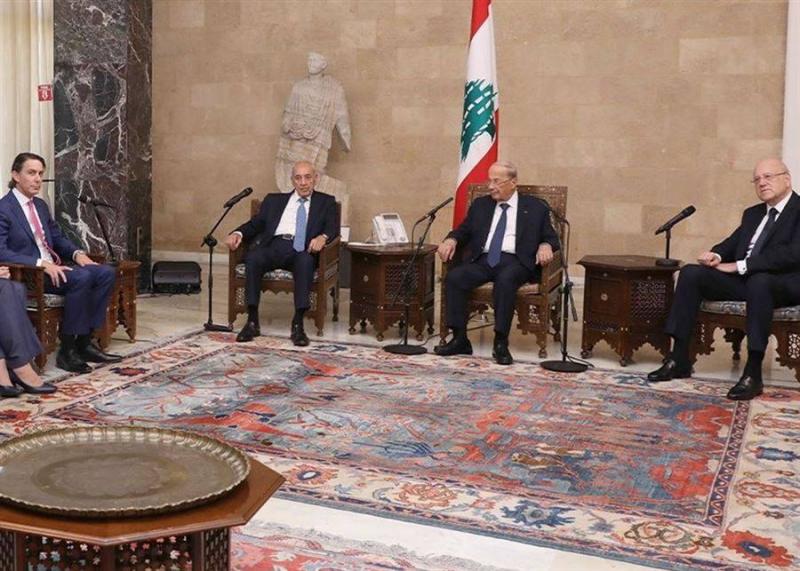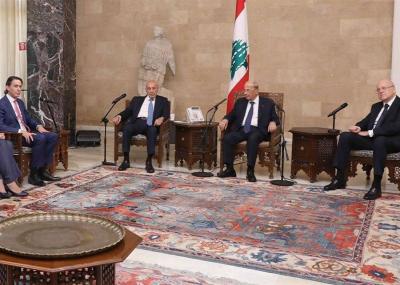The celebration of the Lebanese Army Day restored the connections that had been severed between President Michel Aoun, Speaker of the Parliament Nabih Berri, and caretaker Prime Minister Najib Mikati. During this celebration, Aoun notably expressed concern about the governmental situation, fearing that the paralysis in forming a new government would extend to the presidential elections, leaving Lebanon without a president after the expiry of his term on October 31.
The governmental file was entirely absent from the meeting of the three presidents in Baabda with American mediator Amos Hochstein, U.S. Ambassador Dorothy Shea, Deputy Speaker Elias Bou Saab, and the Director General of General Security, Major General Abbas Ibrahim, which exclusively focused on the maritime border demarcation file. The atmosphere of optimism that prevailed after this meeting was expressed by Hochstein himself. Bou Saab also noted the positive ambiance of the meeting and the narrowing gap on the disputed issues between Lebanon and Israel, as described by Hochstein, especially after reaffirming Lebanon's united stance on retaining the entirety of the Qana field.
How did the expert references in the demarcation file perceive the optimistic atmosphere that prevailed after the meeting of the three presidents with Hochstein in Baabda? Former MP Brigadier General Wahbi Qatisha noted in a conversation with electronic news outlets that what was announced following the Baabda meeting brought no new developments, and that everything declared did not differ either in form or content from the results achieved by Lebanon in the demarcation negotiations that took place ten years ago during Prime Minister Fouad Siniora's government.
Siniora had referred to this just a few weeks ago, and it is the same framework agreement that Berri repeatedly highlighted before the file came under President Aoun's jurisdiction. He described the drones sent by Hezbollah to Karish and the video footage released simultaneously with Hochstein's visit to Beirut as mere attempts to deceive the public into believing that without Hezbollah and its threats, this agreement would not have been reached. Citing his military expertise, Qatisha clarified that the 23 line, adjacent to the Qana field, runs along the southern edge of the boundary line between Lebanese territory and the territorial waters of occupied Palestine. Thus, Lebanon aimed to retain the entire Qana field, and it seems that Israel has agreed to this, with the matter now nearing its final details, although the specific indentations Israel desires from the 23 line remain unclear.
Regarding Aoun's urgency to sign the demarcation before the end of his term, he stated, "I do not know if the demarcation will be presented as a gift to the term that is nearing its end or to the term that may follow it."
Additionally, sources from the Amal Movement and Hezbollah firmly confirmed that the demarcation file is regarded as practically completed, and the meeting of the three presidents with the American mediator is a clear signal that the file is nearing its conclusion. Otherwise, what is the justification for Hochstein's meeting with the state’s main figures in the presence of the U.S. Ambassador and General Ibrahim?
Regarding Hezbollah's threats to prevent Israel from extracting gas from Karish and the released video footage, sources from the duo called for a careful re-reading of Hezbollah Secretary-General Hassan Nasrallah's recent statements, paying attention to every word he said: that Hezbollah has no involvement in the demarcation issue and does not wish to replace the state. This confirms that the party is in agreement with Berri's role in this matter, and, according to these sources, Berri is central to the entire story regarding the demarcation file.
Monitoring sources reported to Al-Anbaa electronic newspaper about the two-dimensional and three-dimensional surveys and the locations of hydrocarbon materials, which determine the areas where oil is present. This was confirmed by Israel in the Karish field, located next to the Qana field. Gas is expected to exist between geological layers at depths ranging from 2,000 to 3,000 feet, requiring significant effort to collect and extract. The question remains: who guarantees that Israel has not seized part of the oil and gas reserves and left the rest for Lebanon? It is important to keep in mind that the exploration takes place in the depths of the sea and not on the water's surface; according to sources, the situation is precarious despite discussions about nearing the hoped-for agreement.




